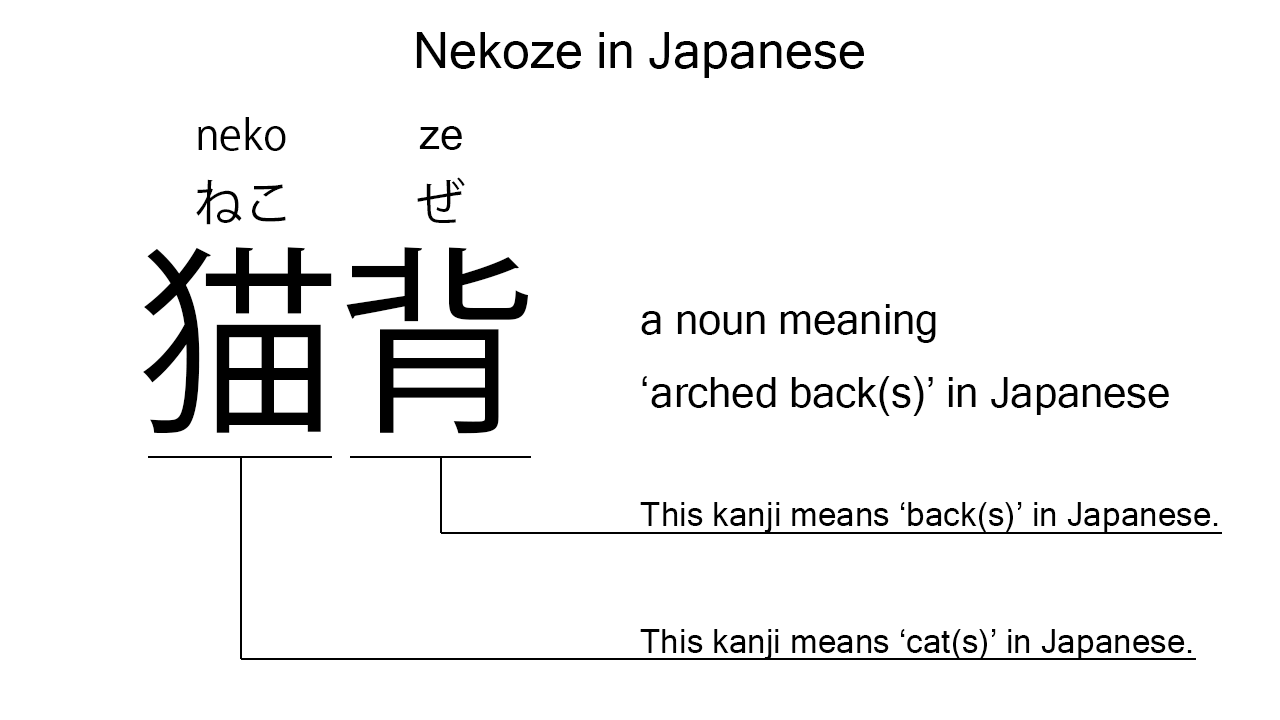What does “nekoze” mean in Japanese?
Native speakers say “nekoze” to mean ‘arched back’ in Japanese. Perhaps, some Japanese learners know this word as it is sometimes used in Japanese movies, novels, manga, anime, and the like. In this blog post, however, I will explain this word in detail based on its kanji expression. And also, I will explain how to use it through example sentences. My explanations would help Japanese learners understand “nekoze” more clearly. Then, let’s get started!
Contents
Definition and meaning of “nekoze”
Let me start with the definition and meaning of “nekoze”.
- nekoze – 猫背 (ねこぜ) : a noun meaning ‘arched back’ in Japanese.
Japanese native speakers use this noun to refer to an arched back posture or sometimes someone who has an arched back.
The definition and meaning are simple and clear. To understand this noun more clearly, however, let me explain its kanji characters in detail, one by one.
Nekoze in kanji
The kanji expression of “nekoze” consists of the following two kanji characters:
- 猫 : a kanji character used to mean ‘cat’ in Japanese.
- 背 : a kanji character used to mean ‘back’ in Japanese. This can also be found in other words like “senaka“.
These two kanji characters tell us that the formed noun literally means a ‘cat back’ in Japanese. This literal interpretation is not completely in line with the actual meaning, but still understandable, I think. A cat’s back is indeed arched.

When we meet new kanji expressions, we should check their kanji characters in detail to understand their meanings clearly and deeply. In many cases, kanji characters tell us a lot about the meanings of the expressions they form. Actually, here, we could get the better understanding of “nekoze” through the detailed kanji check above.
So far, I’ve explained the definition and meaning of “nekoze” together with its kanji characters. Then, let me explain how to use it through the example sentences below.
Example #1: how to say “arched back” in Japanese
kanojo wa nekoze desu – 彼女は猫背です (かのじょはねこぜです)
She has an arched back.
Below are the new words used in the example sentence.
- kanojo – 彼女 (かのじょ) : a pronoun meaning ‘she’ in Japanese.
- wa – は : a binding particle working as a case marker or topic marker. In the example, this works after “kanojo” to make the subject in the sentence.
- desu – です : an auxiliary verb used after a noun or adjective to make it polite. Probably, this is well known as a part of Japanese desu form. In the example, this is used after “nekoze” to make it sound polite.
This is a typical usage of “nekoze”. In this example, it works as the complement in the sentence. When we want to refer to an arched back posture in Japanese, this noun is a very good option.
Example #2: another usage of “nekoze”
watashi wa nekoze wo naoshi tai – 私は猫背を治したい (わたしはねこぜをなおしたい)
I want to fix my arched back.
Below are the new words used in the example sentence.
- watashi – 私 (わたし) : a pronoun meaning ‘I’ in Japanese.
- wo – を : a case particle used to make the object word in a sentence. In the example, this is used after “nekoze” to make the object in the sentence.
- naoshi – 治し (なおし) : one conjugation of the verb, “naosu“, which means ‘to fix’ or such in Japanese. In the example, it has been conjugated for the better connection with its following word.
- tai – たい : an auxiliary verb used after a verb to make its desire form. In the example, this is used after “naoshi” to make its desire form, “naoshi tai”, which means ‘to want to fix’ in Japanese.
This is another typical usage of “nekoze”. In this example, it works together with the case particle, “wo”, to become the object in the sentence.
Summary
In this blog post, I’ve explained the definition and meaning of “nekoze” in detail based on its kanji expression. And also, I’ve explained how to use it through the example sentences. Let me summarize them as follows.
- nekoze – 猫背 (ねこぜ) : a noun meaning ‘arched back’ in Japanese. Japanese native speakers use this noun to refer to an arched back posture or sometimes someone who has an arched back. These two kanji characters literally mean a ‘cat back’ in Japanese. This literal interpretation is not completely in line with the actual meaning, but still understandable, I think. A cat’s back is indeed arched.
Hope my explanations are understandable and helpful for Japanese learners.